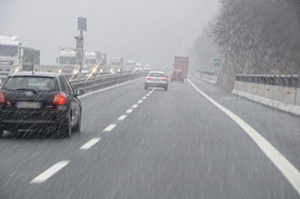 Driving for long distances can be an enjoyable experience. Whether you’re going on a road trip or simply trying to get from Point A to Point B, the experience of driving at your own pace can be a rewarding one.
Driving for long distances can be an enjoyable experience. Whether you’re going on a road trip or simply trying to get from Point A to Point B, the experience of driving at your own pace can be a rewarding one.
However, driving for longer periods of time can also expose you to new hazards and risks such as driver fatigue. It’s important for everyone on the road to be practising safe motoring habits, and this is particularly true for those who have a long journey ahead of them.
With the winter months now here, there’s even more reason to drive safely at all times. Rainfall, snow and ice can add an extra element to the experience that drivers need to account for. According to the Transport for NSW Centre for Road Safety, in the year ended December 2012, wet surface conditions were a factor in 8,404 crashes. Of these, 51 were fatal, 3,162 resulted in an injury and 5,191 had no casualties.
Meanwhile, snow or ice on the roads was a factor in 80 crashes during that year, 28 of which resulted in injury and 52 with no casualties.
To make sure you’re driving to the conditions and as prepared as you can be for a long-distance drive, here are some essential tips to keep in mind.
Driving in rain or on icy roads
Remember that your vehicle may handle differently depending on the weather conditions. Wet or slippery roads will make it harder to brake in time, so increase the amount of braking distance you think you need at any given moment.
Grip may also be affected, so keep a safe distance between your vehicle and others on the road. This will give you more time to react if you or another driver fall prey to the difficult conditions. If rainfall is torrential, your visibility will be compromised.
If you can, pull over to the side of the road and wait for the rain to lessen or cease before attempting to move on. Make use of dipped headlights to give you enough room to see, without affecting other drivers coming towards you.
Some cars are equipped with a cruise control, but this should never be activated on slippery surfaces. If you’re driving on wet or icy roads, you want to have as much control over your vehicle as possible.
Keep to the speed limit at all times, but don’t be afraid to take your time and go slowly while accelerating, decelerating, turning or braking. Applying gradual pressure to the accelerator is the best way to avoid skidding, and remember to slow down for stop lights well in advance.
What to do before you leave
If you’ve got a long distance journey coming up, keep an eye on the weather reports for your area. If you can, try to time your trip with better weather conditions and make sure others know your estimated time of arrival, destination and chosen route.
Check your engine and all components of your vehicle, to make sure everything is running smoothly. It’s a good idea to keep a physical map in the car as well, in case your GPS fails.
This is also the time to make sure all your emergency measures are in place – keep your first aid kit fully stocked.
What to do throughout your journey
Give yourself regular rest breaks to avoid the risk of driver fatigue – at least 15 minutes every two hours is recommended. During these breaks, use the opportunity to clean your windscreen, headlights and brake lights of any debris or grime that may have built up during the previous leg of your journey.
Keep the temperature within the car at a comfortable level – too much warmth can induce drowsiness, especially if you didn’t get sufficient sleep the night before.
If you can, share the driving between you and another fully licenced, experienced driver. If you do feel fatigued, it’s best to stop somewhere and sleep it off rather than trying to drive when you are not fully alert.
your opinion matters: